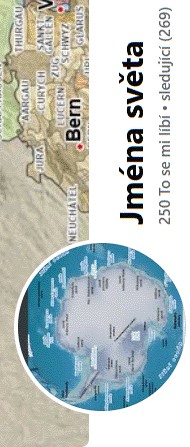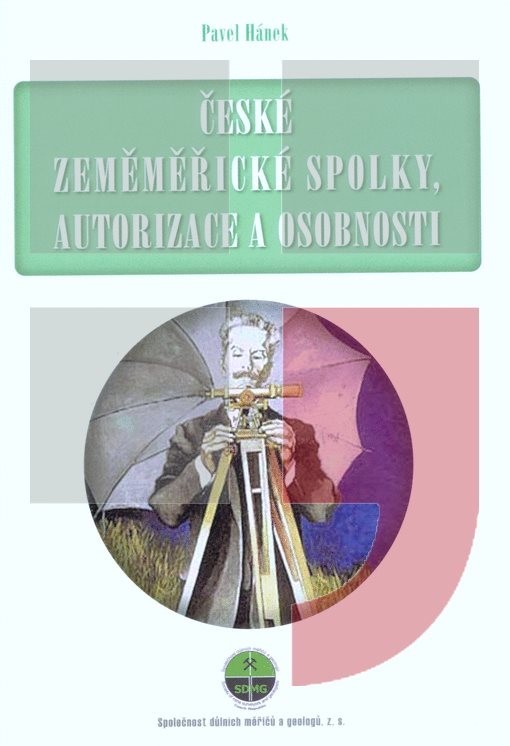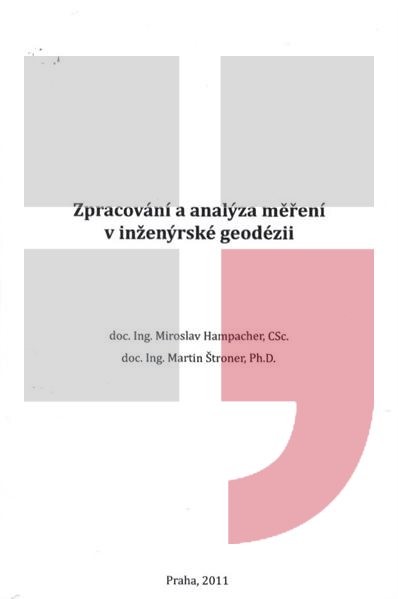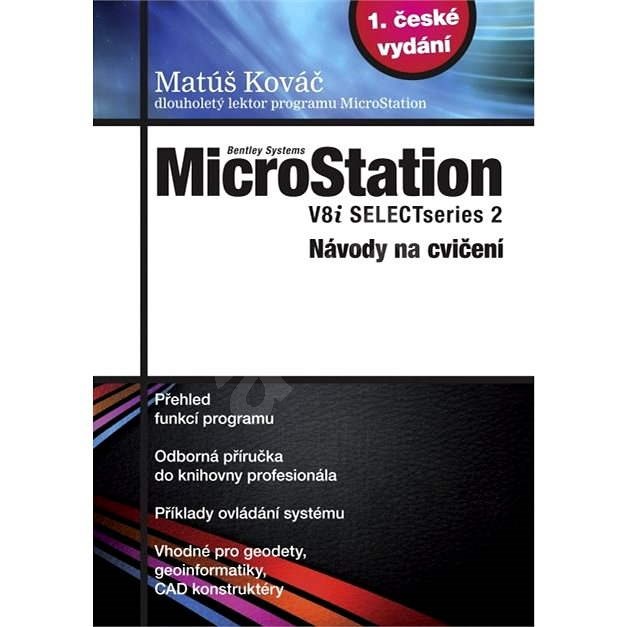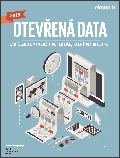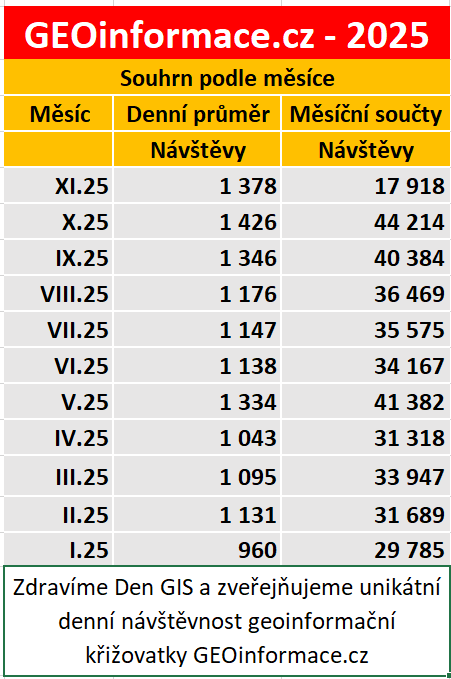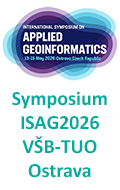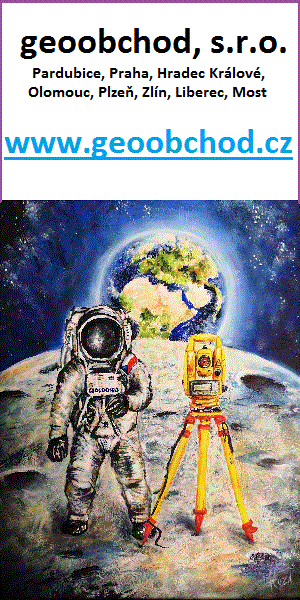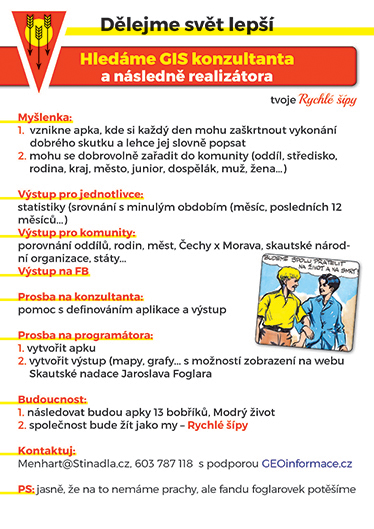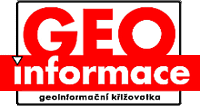zprávy
zdroje zpráv:Vedoucí oddělení aktualizace KN – odborný rada
9.11.2022 10:23 ČÚZK - volná místa Katastrální úřad pro Středočeský kraj Katastrální pracoviště Příbram vypisuje výběrové řízení na místo Vedoucí oddělení aktualizace KN – odborný radaMechanické kalkulačky či rekonstrukce slunečních hodin. 42. sympozium z dějin geodézie a kartografie má zajímavý program
9.11.2022 9:32 ZeměměřičMechanické kalkulačky či rekonstrukce slunečních hodin. Podívejte se do celého programu 42. sympozia z dějin geodézie a kartografie Antonín Švejda z Národního technického muzea pořádá 42. sympozium z dějin geodézie a kartografie. Akce se uskuteční 30. listopadu 2022 v Praze. Do programu letošního sympozia jsou následující referáty Vltava – proměny historické krajiny – Jiří Cajthaml, Tomáš Janata, Jiří Krejčí Zkušební tisky starých map a jejich význam […]
The post Mechanické kalkulačky či rekonstrukce slunečních hodin. 42. sympozium z dějin geodézie a kartografie má zajímavý program appeared first on Zeměměřič.
Nejen města a obce využívají mapové aplikace. Národní park Podyjí si turisté od letoška prohlížejí i on-line (TZ)
9.11.2022 8:31 GISportal.cz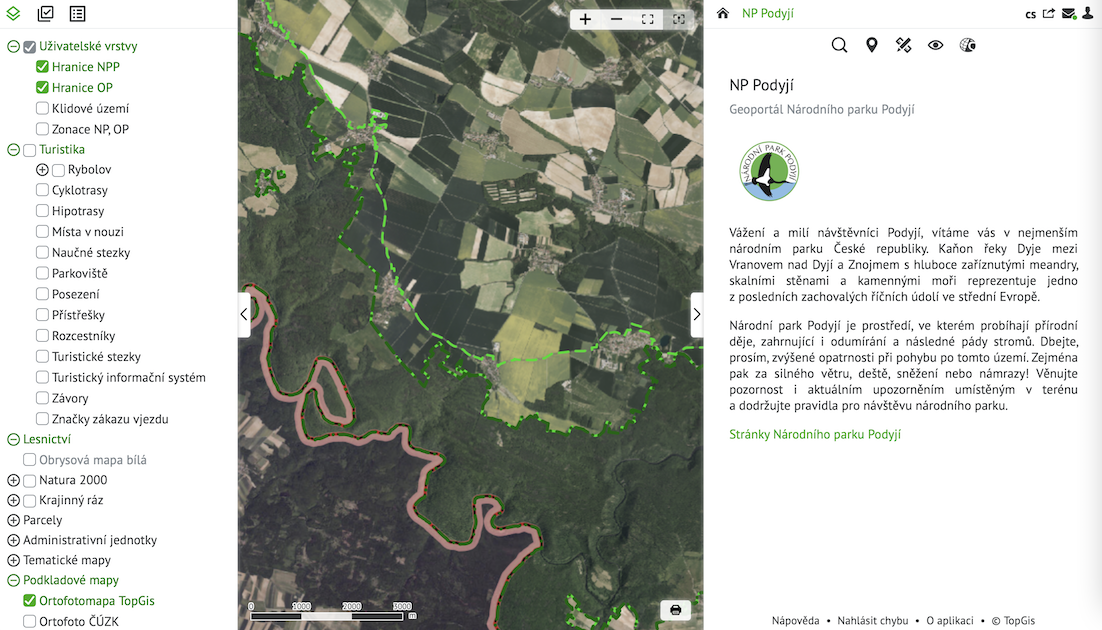
Mapové aplikace kombinující aktuální ortofotomapy s informacemi o inženýrských sítích, dopravním značení či mobiliářích patří do tradičního portfolia nástrojů řady tuzemských měst a obcí. Jejich uplatnění je ale daleko širší, využití najdou například i u národních parků. Od letoška je mapový portál volně přístupný pro návštěvníky Národního parku Podyjí. Lidé se tak mohou on-line podívat, kudy […]
The post Nejen města a obce využívají mapové aplikace. Národní park Podyjí si turisté od letoška prohlížejí i on-line (TZ) appeared first on GISportal.cz.
Nejen města a obce využívají mapové aplikace. Národní park Podyjí si turisté od letoška prohlížejí i on-line (TZ)
9.11.2022 8:31 GISportal.cz
Mapové aplikace kombinující aktuální ortofotomapy s informacemi o inženýrských sítích, dopravním značení či mobiliářích patří do tradičního portfolia nástrojů řady tuzemských měst a obcí. Jejich uplatnění je ale daleko širší, využití najdou například i u národních parků. Od letoška je mapový portál volně přístupný pro návštěvníky Národního parku Podyjí. Lidé se tak mohou on-line podívat, kudy […]
The post Nejen města a obce využívají mapové aplikace. Národní park Podyjí si turisté od letoška prohlížejí i on-line (TZ) appeared first on GISportal.cz.
20221027 - volné místo – Odborný/vrchní referent v OAaD KP Ústí n.L. na Katastrálním úřadu pro ÚK
9.11.2022 7:23 ČÚZK /Urady/Katastralni-urady/Katastralni-urady/Katastralni-urad-pro-Ustecky-kraj/Katastralni-pracoviste/KP-Usti-nad-Labem/O-uradu/Aktuality/20221027-volne-misto-–-Odborny-vrchni-referent-v-O20221027 - volné místo – Odborný/vrchní referent v OAaD KP Ústí n.L. na Katastrálním úřadu pro ÚK
9.11.2022 7:23 ČÚZK - předpisy a opatření Katastrální úřad pro Ústecký kraj - Katastrální pracoviště Ústí nad Labem zveřejnil novou aktualitu: Nabídka volného místa - Odborný referent / vrchní referent v oddělení aktualizace a dokumentace katastru nemovitostí Katastrálního pracoviště Ústí nad Labem na Katastrálním úřadu pro Ústecký kraj20221027 - volné místo – Odborný/vrchní referent v OAaD KP Ústí n.L. na Katastrálním úřadu pro ÚK
9.11.2022 7:23 ČÚZK - předpisy a opatření Katastrální úřad pro Ústecký kraj - Katastrální pracoviště Ústí nad Labem zveřejnil novou aktualitu: Nabídka volného místa - Odborný referent / vrchní referent v oddělení aktualizace a dokumentace katastru nemovitostí Katastrálního pracoviště Ústí nad Labem na Katastrálním úřadu pro Ústecký kraj20221027 - volné místo – Odborný/vrchní referent v OAaD KP Ústí n.L. na Katastrálním úřadu pro ÚK
9.11.2022 7:23 ČÚZK /Urady/Katastralni-urady/Katastralni-urady/Katastralni-urad-pro-Ustecky-kraj/O-uradu/Aktuality/20221027-volne-misto-–-Odborny-vrchni-referent-v-OOdborný referent / vrchní referent v oddělení aktualizace a dokumentace katastru nemovitostí Katastr
9.11.2022 7:20 ČÚZK - volná místa Katastrální úřad pro Ústecký kraj Katastrální pracoviště Ústí nad Labem vypisuje výběrové řízení na místo Odborný referent / vrchní referent v oddělení aktualizace a dokumentace katastru nemovitostí KatastrOdborný referent / vrchní referent v oddělení aktualizace a dokumentace katastru nemovitostí Katastr
9.11.2022 7:20 ČÚZK /Urady/Katastralni-urady/Katastralni-urady/Katastralni-urad-pro-Ustecky-kraj/Uredni-deska/Oznameni-a-jina-uredni-sdeleni/Volna-mista/DMS/Odborny-referent-vrchni-referent-v-oddeleni-aktualOdborný referent / vrchní referent v oddělení aktualizace a dokumentace katastru nemovitostí Katastr
9.11.2022 7:20 ČÚZK - předpisy a opatření Katastrální úřad pro Ústecký kraj Katastrální pracoviště Ústí nad Labemvypisuje výběrové řízení na místo
Odborný referent / vrchní referent v oddělení aktualizace a dokumentace katastru nemovitostí Katastrálního pracoviště Ústí nad Labem na Katastrálním úřadu pro Ústecký kraj
XLII. sympozium Z dějin geodézie a kartografie [Knihovna geografie, byTopic]
9.11.2022 0:00 Katedra aplikované geoinformatiky a kartografie Přf UK Národní technické muzeum v Praze srdečně zve na tradiční podzimní setkání, již XLII. sympozium Z dějin geodézie a kartografie, které se koná ve středu 30. 11. 2022 od 9 hodin (Kostelní 42, Praha 7). V rámci doprovodného programu je možné si prohlédnout výstavu 300 let Müllerovy mapy Čech.Watch the Third Quarter 2022 Operating Results
8.11.2022 21:33 Bentley SystemsWatch The First Quarter 2022 Operating Results
The post Watch the Third Quarter 2022 Operating Results appeared first on Bentley Systems | Infrastructure Engineering Software Company.Watch the Third Quarter 2022 Operating Results
8.11.2022 21:33 Bentley SystemsWatch The First Quarter 2022 Operating Results
The post Watch the Third Quarter 2022 Operating Results appeared first on Bentley Systems | Infrastructure Engineering Software Company.The Applying IFC 4.3 for Rail Detailed Project Plan has been reviewed and unanimously been endorsed by the Standards Committee.
8.11.2022 20:00 buildingSMART.orgThe Standards Committee feedback and results can be viewed using the following link. Go to document
The post The Applying IFC 4.3 for Rail Detailed Project Plan has been reviewed and unanimously been endorsed by the Standards Committee. appeared first on buildingSMART International.
Výběrové řízení na pozici rozhodování o povolení vkladu v oddělení právních vztahů k nemovitostem Ka
8.11.2022 13:55 ČÚZK - volná místa Katastrální úřad pro Pardubický kraj Katastrální pracoviště Svitavy vypisuje výběrové řízení na místo Výběrové řízení na pozici rozhodování o povolení vkladu v oddělení právních vztahů k nemovitostem KaVýběrové řízení na pozici rozhodování o povolení vkladu v oddělení právních vztahů k nemovitostem Ka
8.11.2022 13:55 ČÚZK /Urady/Katastralni-urady/Katastralni-urady/Katastralni-urad-pro-Pardubicky-kraj/Volna-mista/DMS/Vyberove-rizeni-na-pozici-rozhodovani-o-povoleni-vVýběrové řízení na pozici rozhodování o povolení vkladu v oddělení právních vztahů k nemovitostem Ka
8.11.2022 13:55 ČÚZK - předpisy a opatření Katastrální úřad pro Pardubický kraj Katastrální pracoviště Svitavyvypisuje výběrové řízení na místo
Výběrové řízení na pozici rozhodování o povolení vkladu v oddělení právních vztahů k nemovitostem Katastrálního pracoviště Svitavy
Nové verze 16.10
8.11.2022 12:45 GEPROPřipravili jsme pro vás nové verze 16.10 našich produktů. Stahovat je můžete z obvyklého umístění na našem download serveru. Novinky, které jsme pro vás nachystali: KOKEŠ MISYS GEOPORTÁL PROLAND Obecné změny ve všech produktech Nové funkce Nyní si aplikace ukládá polohy a rozměry dialogových oken. Nová funkce Registrace klíče je dostupná v menu Help. Práce …
Nové verze 16.10 Pokračovat ve čtení »
Článek Nové verze 16.10 se nejdříve objevil na GEPRO.
odborný referent – poskytování informací KN a PK, poskytování podkladů, nahlížení do KN
8.11.2022 12:34 ČÚZK - volná místa Katastrální úřad pro Olomoucký kraj Katastrální pracoviště Prostějov vypisuje výběrové řízení na místo odborný referent – poskytování informací KN a PK, poskytování podkladů, nahlížení do KNodborný referent – poskytování informací KN a PK, poskytování podkladů, nahlížení do KN
8.11.2022 12:34 ČÚZK /Urady/Katastralni-urady/Katastralni-urady/Katastralni-urad-pro-Olomoucky-kraj/Uredni-deska/Oznameni-a-jina-uredni-sdeleni/Volna-mista/DMS/odborny-referent-–-poskytovani-informaci-KN-a-PK,-odborný referent – poskytování informací KN a PK, poskytování podkladů, nahlížení do KN
8.11.2022 12:34 ČÚZK - předpisy a opatření Katastrální úřad pro Olomoucký kraj Katastrální pracoviště Prostějovvypisuje výběrové řízení na místo
odborný referent – poskytování informací KN a PK, poskytování podkladů, nahlížení do KN
Call for Media: launch of the first Meteosat Third Generation satellite MTG-I1
8.11.2022 9:37 ESA Observing the Earth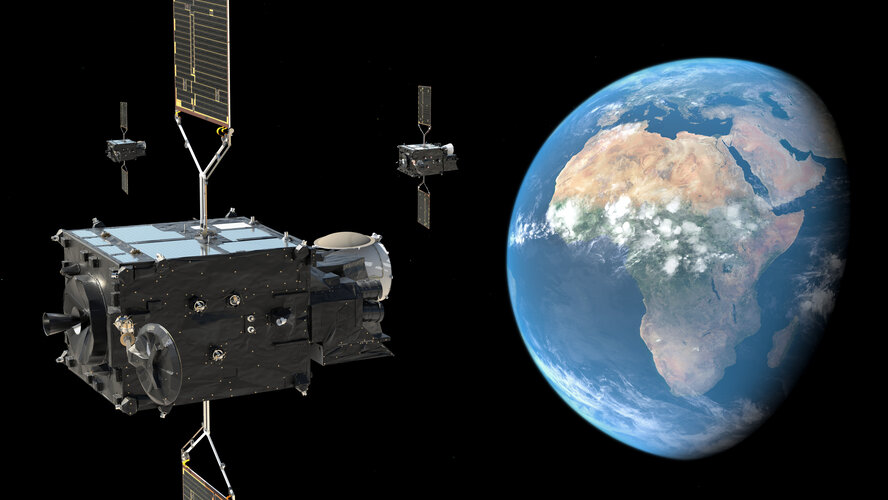
Call for Media: launch of the first MTG satellite MTG-I1
3. INSPIRE ESPUS konference & 13. ročník Inspirujme se…efektivitou (pozvánka)
8.11.2022 9:04 GISportal.cz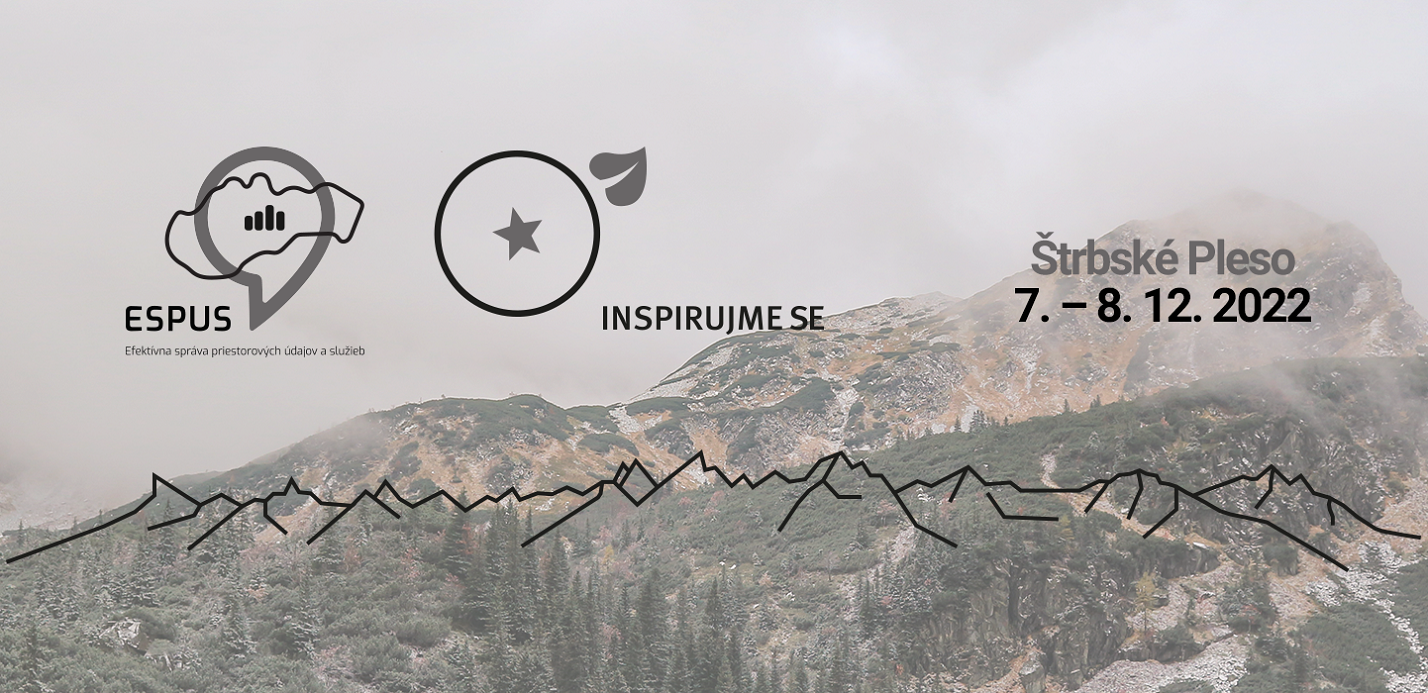
Ministerstvo životného prostredia Slovenskej republiky a Česká informační agentura životního prostředí Vás zvou ve dnech 7.– 8. 12. 2022 na Štrbské Pleso, kde se uskuteční „3. INSPIRE ESPUS konference & 13. ročník Inspirujme se…efektivitou“. REGISTRACE, PŘIHLAŠOVÁNÍ PREZENTACÍ A POSTERŮ Účast na akci je pro všechny registrované účastníky zdarma – do naplnění kapacity. Registrační formulář najdete […]
The post 3. INSPIRE ESPUS konference & 13. ročník Inspirujme se…efektivitou (pozvánka) appeared first on GISportal.cz.
3. INSPIRE ESPUS konference & 13. ročník Inspirujme se…efektivitou (pozvánka)
8.11.2022 9:04 GISportal.cz
Ministerstvo životného prostredia Slovenskej republiky a Česká informační agentura životního prostředí Vás zvou ve dnech 7.– 8. 12. 2022 na Štrbské Pleso, kde se uskuteční „3. INSPIRE ESPUS konference & 13. ročník Inspirujme se…efektivitou“. REGISTRACE, PŘIHLAŠOVÁNÍ PREZENTACÍ A POSTERŮ Účast na akci je pro všechny registrované účastníky zdarma – do naplnění kapacity. Registrační formulář najdete […]
The post 3. INSPIRE ESPUS konference & 13. ročník Inspirujme se…efektivitou (pozvánka) appeared first on GISportal.cz.
New call for Erasmus Mundus Master Degree
8.11.2022 8:22 Katedra geoinformatiky UP OlomoucWe are happy to announce that the new call for the Erasmus Mundus Joint master’s degree is now open till Dec 20, 2022! Apply now https://www.master-cde.eu/adm…/procedures-deadlines/calls/ We offer an outstanding and distinctive Erasmus Mundus Joint Master (double degree) experience to our graduate students. The two-year full-time integrated programme’s board is looking for students who […]
The post New call for Erasmus Mundus Master Degree appeared first on Katedra geoinformatiky.
Začínáme novou éru GISportalu
8.11.2022 7:43 GISportal.cz
GISportal se dohodl s portálem data.brno na spolupráci. Postupně budeme navzájem sdílet články, či re-postovat některé starší, ale stále zajímavé/aktuální články z data.Brno, na GISportale a věříme, že podobnou formu spolupráce bychom mohli navázat i s jinými pracovišti – např. IPR Praha, MAPPA Ostrava, či s portálem otevřených dat (data.gov.cz). Budeme moc rádi, když se […]
The post Začínáme novou éru GISportalu appeared first on GISportal.cz.
Začínáme novou éru GISportalu
8.11.2022 7:43 GISportal.cz
GISportal se dohodl s portálem data.brno na spolupráci. Postupně budeme navzájem sdílet články, či re-postovat některé starší, ale stále zajímavé/aktuální články z data.Brno, na GISportale a věříme, že podobnou formu spolupráce bychom mohli navázat i s jinými pracovišti – např. IPR Praha, MAPPA Ostrava, či s portálem otevřených dat (data.gov.cz). Budeme moc rádi, když se […]
The post Začínáme novou éru GISportalu appeared first on GISportal.cz.
Pozvánka na přednášku Climate and pre-industrial subsistence crises in Finland
8.11.2022 0:00 Geografický ústav MUPozvánka na přednášku CLIMATE AND PRE-INDUSTRIAL SUBSISTENCE CRISES IN FINLAND
8.11.2022 0:00 Geografický ústav MUKARTOVÝROČÍ 2022 & Mezníky digitální kartografie [Knihovna geografie, byTopic]
8.11.2022 0:00 Katedra aplikované geoinformatiky a kartografie Přf UK Česká kartografická společnost zve své členy i všechny zájemce o mapy a kartografii na seminář KARTOVÝROČÍ 2022 & Mezníky digitální kartografie, který se uskuteční ve čtvrtek 10. listopadu 2022 v prostorách Fakulty stavební ČVUT v Praze. Zajímavý program je připraven na celé odpoledne od 13:30 do 17 hodin.Ve čtvrtek 17. listopadu 2022 bude zavřeno [Knihovna geografie, byTopic]
8.11.2022 0:00 Katedra aplikované geoinformatiky a kartografie Přf UK Státní svátek Den boje za svobodu a demokracii a Mezinárodní den studenstva připadá na čtvrtek, ve který bude Knihovna geografie uzavřena.Bentley Systems Announces Operating Results for the Third Quarter of 2022
7.11.2022 17:19 Bentley SystemsBentley Systems, Incorporated (Nasdaq: BSY) the infrastructure engineering software company, today announced operating results for its second
quarter and six months ended June 30, 2022.
Bentley Systems Announces Operating Results for the Third Quarter of 2022
7.11.2022 17:19 Bentley SystemsBentley Systems, Incorporated (Nasdaq: BSY) the infrastructure engineering software company, today announced operating results for its second
quarter and six months ended June 30, 2022.
Integration of EC3 with the Bentley iTwin Platform for Infrastructure Carbon Calculation
7.11.2022 16:43 Bentley SystemsNovember 7, 2022 | Press Announcement Read More
The post Integration of EC3 with the Bentley iTwin Platform for Infrastructure Carbon Calculation appeared first on Bentley Systems | Infrastructure Engineering Software Company.Integration of EC3 with the Bentley iTwin Platform for Infrastructure Carbon Calculation
7.11.2022 16:43 Bentley SystemsNovember 7, 2022 | Press Announcement Read More
The post Integration of EC3 with the Bentley iTwin Platform for Infrastructure Carbon Calculation appeared first on Bentley Systems | Infrastructure Engineering Software Company.odborný/vrchní referent v oddělení aktualizace katastru nemovitostí Katastrálního pracoviště Chrudim
7.11.2022 14:10 ČÚZK - předpisy a opatření Katastrální úřad pro Pardubický kraj Katastrální pracoviště Chrudimvypisuje výběrové řízení na místo
odborný/vrchní referent v oddělení aktualizace katastru nemovitostí Katastrálního pracoviště Chrudim
odborný/vrchní referent v oddělení aktualizace katastru nemovitostí Katastrálního pracoviště Chrudim
7.11.2022 14:10 ČÚZK - volná místa Katastrální úřad pro Pardubický kraj Katastrální pracoviště Chrudim vypisuje výběrové řízení na místo odborný/vrchní referent v oddělení aktualizace katastru nemovitostí Katastrálního pracoviště Chrudimodborný/vrchní referent v oddělení aktualizace katastru nemovitostí Katastrálního pracoviště Chrudim
7.11.2022 14:10 ČÚZK /Urady/Katastralni-urady/Katastralni-urady/Katastralni-urad-pro-Pardubicky-kraj/Uredni-deska/Oznameni-a-jina-uredni-sdeleni/Volna-mista/DMS/odborny-vrchni-referent-v-oddeleni-aktualizace-(1)Ohlédnutí za Konferencí GIS Esri v ČR
7.11.2022 14:02 ARCDATAKonference GIS Esri v ČR se konala ve dnech 1. a 2. listopadu 2022 v Cubex Centru Praha. Konference je tradičním setkáním geoinformatiků a uživatelů systému ArcGIS, které se v předchozích dvou letech bohužel muselo pořádat pouze virtuálně. Letos se však konečně podařilo uspořádat setkání tradičním způsobem.
Úvodní blok přednášek – význam GIS, energetika a naše společnost
Konferenci svým vystoupením zahájil ředitel ARCDATA PRAHA Petr Seidl, který účastníky přivítal a promluvil o možnostech, které technologie GIS poskytuje v nejrůznějších odvětvích – zmínil například, že v České republice používá systém ArcGIS přes 1400 organizací ze 44 oborů. Jedním z hlavních témat úvodní řeči byla také charakteristika moderního GIS, který tím, že je založen na webových službách, lépe pomáhá vzájemné spolupráci než ve své předchozí, převážně desktopové podobě.
Úvodní blok konference ale již tradičně stojí na zajímavých, mezioborových přednáškách. Po svém úvodu proto Petr Seidl pozval na pódium ředitele Institutu plánování a rozvoje hl. m. Prahy Ondřeje Boháče a ředitele sekce prostorových informací IPR Jiřího Čtyrokého, kteří v létě, na světové konferenci Esri, převzali za Institut plánování a rozvoje hl. m. Prahy od společnosti Esri ocenění Presidents Award. Jedná se o nejvyšší ocenění udělované pouze jednou ročně a IPR se jejím převzetím zařadil mezi takové společnosti, jakými jsou například UPS, americký Červený kříž nebo agentura ochrany životního prostředí USA (EPA). Oba zástupci seznámili posluchače se zajímavými projekty, které IPR v současnosti řeší.
Významnými uživateli GIS jsou také správci inženýrských sítí. Program se proto dále věnoval společnosti ČEVAK a.s., kterou Petr Seidl ocenil za komplexní nasazení GIS. Cenu si z jeho rukou převzali Jiří Lipold, technický ředitel ČEVAK a.s., a Petr Kestler, vedoucí oddělení vyjadřovací činnosti.
Jedním z hlavních řečníků konference byl Václav Cílek, který v přednášce „Energetika jako sociální síla“ poukázal na to, že využívání různých nerostných a energetických zdrojů podněcuje konkrétní změny ve společnosti. Například bez stříbra by tak brzy nevznikla fotografie a naše vizuální kultura a způsoby zachycování vzpomínek by byly odlišné. I u energetiky a při využívání různých zdrojů lze vystopovat podobné vazby.
Předsedkyně Státního úřadu pro jadernou bezpečnost Dana Drábová a přední český klimatolog Radim Tolasz se na jevišti „setkali v kavárně“, kde spolu vedli zajímavý rozhovor o současném stavu energetiky, ale také o dlouhodobých vyhlídkách v energetické oblasti a o probíhající klimatické změně.
Svět se mění a lidská společnost nyní čelí úkolu, jakým způsobem probíhající změny zastavit, zpomalit či jak se jim přizpůsobit. Technologie budou v tomto procesu hrát klíčovou roli. Petr Seidl tak v závěru své řeči apeloval na posluchače, že GIS je díky své schopnosti nacházet nové souvislosti jednou z technologií, které mohou mít zásadní vliv, a je na každém z nás, abychom se tuto výzvu, kterou před nás svět staví, pokusili přijmout a překonat.
Technologická sekce plná novinek a zajímavostí
Technologický blok začal Radek Kuttelwascher ukázkou několika zajímavých tipů pro desktopovou aplikaci ArcGIS Pro. Pak následovala ukázka principu webového GIS, který má každý uživatel prostřednictvím nástrojů a aplikací na ArcGIS Online k dispozici. Cyril Dynka Mrva si přinesl tablet a ukázal, jak prostřednictvím některé z mobilních aplikací (ArcGIS QuickCapture, ArcGIS Field Maps a ArcGIS Survey123) vytvořit data v terénu a jak je také případně editovat. Slovo si od něj vzal Prokop Kuranda a ukázal, jak z těchto dat vytvořit webovou mapu a z ní pak interaktivní aplikaci, kterou mohou používat kolegové v organizaci –nebo třeba i veřejnost. Markéta Braunová pak použila stejná data, prostřednictvím ArcGISDashboards vytvořila přehledový panel, a nakonec i prezentaci formou webové stránky ArcGIS StoryMap. Celá ukázka netrvala déle než několik minut a předvedla, jak rychle lze s dnešními technologiemi vytvořit specializované aplikace, které pracují s živými daty.
Následovaly ukázky konkrétnějších technologií. Inka Tesařová seznámila s možnostmi práce s družicovými a leteckými snímky v prostředí ArcGIS Online – ArcGIS Image for ArcGIS Online. Další ukázka se týkala možností automatizace systému ArcGIS prostřednictvím notebooků programovacího jazyka Python, které jsou do prostředí ArcGIS těsně integrovány. Matej Vrtich ukázal, jak s nimi pracovat v ArcGIS Pro a ArcGIS Enterprise.
Dále se přednášky věnovaly datům. Součástí databáze ArcČR 4.1 je i ukázková geodatabáze ArcTRN, ve které jsou prezentovány některé zajímavé typy dat, které geodatabáze podporuje. Lucie Patková ukázala, jak se dá k prostorovým datům udržovat topologie a pro jaké účely je topologie dobrá. V 3D datech se skrývá budoucnost GIS, proto byly představeny i některé postupy, jak 3D data pro GIS připravit a jak s nimi pracovat. Vladimír Holubec například ukázal, jak pomocí dat a služeb ČÚZK vytvořit 3D budovy a jak do GIS zahrnout i data ze systémů BIM – Building Information Model, a to prostřednictvím aplikace ArcGIS GeoBIM.
ArcGIS Urban slouží k usnadnění úloh územního plánování a o svoje poznatky při práci s touto aplikací se podělil Jan Kabrhel. Lucie Patková pak předvedla připravovanou aplikaci SURE for ArcGIS, která slouží ke zpracování leteckých snímků a snímků z dronů.
GIS je ale možné používat i z Excelu, což ukázal Radek Kuttelwascher s pomocí nástroje ArcGIS for Office. Následovalo představení ArcGIS Indoors, aplikace sloužící k navigaci, orientaci a práci v interiérech. Lucie Patková ukázala, jak ArcGIS Indoors funguje v sídle firmy ARCDATA PRAHA.
Že lze data editovat na podkladu ortofota ví již asi každý. Že je to ale možné i přímo z videa? To předvedl Vladimír Holubec pomocí funkcionality Full Motion Video. Video z dronu je zde možné georeferencovat a propojit jej s existujícími geodaty. Vladimír Holubec pak ještě předvedl nástroj pro monitoring činnosti GIS serverů – ArcGIS Monitor.
Grafové databáze obsahují entity a definují vztahy mezi nimi. I ty lze ale prostřednictvím modulu ArcGIS Knowledge pro ArcGIS Pro zobrazit v mapě.
Večerní blok nejen o veřejné správě
Ondřej Boháč hovořil o problematice standardu pro digitální územní plán a představil návrh CityDeal. Petr Kestler, Vladimír Plachý a Ondřej Tenkl navázali na své vystoupení v hlavním bloku přednášek a hovořili o procesu nasazení ArcGIS ve správě společnosti ČEVAK a.s. Petr Klauda představil projekt statistického geoportálu, který bude zejména prostorem pro sdílení a využití dat ze Sčítání lidu, domů a bytů 2021 – ale nejen to. Poté Tomáš Merta a Tomáš Slezák představili datový portál Data KHK a Katalog otevřených dat Královéhradeckého kraje v přednášce nabité informacemi.
Celý blok uzavřela debata o využití Digitální technické mapy z pohledu měst. O své zkušenosti a očekávání se v ní podělili Lenka Hrčková z města Brna, Jaroslav Škrobák z Jihlavy a Marek Drozdek z Opavy.
Druhý den konference
Ve středu již měli návštěvníci k dispozici dva souběžné bloky přednášek. Ten první se týkal veřejné správy a zahájila jej Jitka Coufalová z odboru eGovernmentu Ministerstva vnitra a hovořila o aktuálním stavu implementace GeoInfoStrategie2020+. Stanislav Štangl hovořil o implementaci systému ArcGIS pro město Plzeň. O rozsáhlém projektu hodnocení priorit pro územní rozvoj Jihlavy hovořili zástupci města, Vít Zeman a Kateřina Bezděkovská, a Jaroslav Burian ze společnosti Urban Planner, která zajistila metodiku a zajištění projektu z pohledu GIS. Že 3 je víc než 2 dobře ví i představitelé statutárního města Ostravy, kteří připravili prezentaci rozvojových zón pro potenciální investory ve 3D. Denisa Poskerová ukázala, jak aplikace vypadá a co se v ní zájemci o investování v Ostravě dozví. Jan Rucký ve své přednášce probral mnoho faktorů využití 3D dat v územním plánování. A nakonec Jaroslav Ambróz ze společnosti Zymestic Solutions představil aplikace, které využívá ZBGIS slovenského katastru nemovitostí.
Sekci o správě infrastruktury zahájil videopřednáškou Matt Piper ze společnosti Esri. Týkala se současných trendů ve využití GIS při správě inženýrských sítí. S velkým zájmem se setkala také přednáška Romana Janečka z Letiště Praha o jejich systému GIS. Spolu s ním úlohu ArcGIS na letišti představil i Václav Wiesner ze společnosti Unicorn Systems. Petr Sýkora z Pražských vodovodů a kanalizací seznámil posluchače se svými zkušenostmi s propojením GIS a BIM a Jiří Buneš z Pragoprojektu přednášel o BIM a GIS v silničních stavbách. David Bargel a Jan Tajovský z Masarykovy univerzity mají mnoho zkušeností s využitím GIS pro facility management. Ve své přednášce se zaměřili zejména na data ze senzorů v inteligentních budovách. Petr Panec ze společnosti Cyclomedia utilitní sekci zakončil přednáškou „Jak si vyrobit fotorealistický 3D GIS snadno a rychle?“
Prof. Lena Halounová, prezidentka ISPRS –International Society for Photogrammetry and Remote Sensing, pronesla úvodní přednášku „rastrového bloku“, charakterizovala různé typy dat, které zahrnujeme pod anglický pojem „imagery“ a upozornila na důležité otázky, které si musí uživatelé zodpovědět, než s těmito daty začnou pracovat. Na to s praktickými ukázkami ve svém workshopu plynule navázala Inka Tesařová. Zdeněk Klusoň ze společnosti PRIMIS se podělil o zkušenosti z leteckého snímkování a leteckého laserového skenování pro potřeby Digitální technické mapy ČR. Nikola Strah ze společnosti PLANET LABS představil nabídku družicových dat, která jeho společnost vytváří a distribuuje.
Odpolední blok uživatelských přednášek začal Radovan Prokeš ze společnosti CEDA. Hovořil o problematice grafu komunikací a autonomních vozidel a představil možnosti ultra HD mobilního mapování. Miroslav Kučera a Kamil Zimmermann hovořili o využití mobilní aplikace ArcGIS Field Maps při správě managementů chráněných území, Zdeněk Kučera přiblížil nasazení a využití aplikací do terénu v Agentuře ochrany přírody a krajiny ČR a Dalibor Fanta ze Státní plavební správy měl přednášku Prostorová data ve světě Říčních informačních služeb.
Rady a návody na workshopech
Odborníci z ARCDATA PRAHA si připravili několik workshopů, na kterých posluchače seznámili s novinkami v technologiích, případně jim poradili s některými postupy a představili zajímavé nástroje. Workshop Mateje Vrticha se zaměřil na možnosti, které správcům i uživatelům přináší nejnovější verze serverového systému ArcGIS Enterprise, a jak na tuto verzi co nejlépe provést upgrade. Mezi nejoblíbenější přednášky tradičně patří workshop Tipy a triky k ArcGIS, který byl letos pod vedením dvou Davidů Nováků z oddělení technické podpory. A o workshopu Inky Tesařové o rastrových datech jsme se již v sekci přednášek zmiňovali.
Vedle toho měli účastníci možnost získat další informace také na šesti čtvrthodinových „miniseminářích“ na témata, jako jsou nástroje pro práci s daty ISKN a RÚIAN, možnosti aplikace ArcGIS Field Maps při tvorbě formulářů pro sběr dat, pokročilé využití tzv. domén v geodatabázi a další.
Webové aplikace a zajímavé mapy
Součástí konference byla také online přehlídka, na kterou se přihlásilo 27 webových aplikací a map. Doplnily je ještě i mapy od studentů z pražské SPŠ stavební Josefa Gočára a ze středních škol z Kraje Vysočina, které ukázaly, že pěkné mapové aplikace na ArcGIS Online vytváří také šikovní studenti.
Závěr konference – těšíme se na další ročník
Na závěr se s účastníky rozloučil ředitel ARCDATA PRAHA Petr Seidl. Shrnul průběh konference a podělil se o několik čísel. Konferenci fyzicky navštívilo téměř 700 účastníků, kteří si poslechli 10 hodin uživatelských přednášek, 5,5 hodin přednášek o technologii a 1,5 hodiny miniseminářů.
Těšíme se na našich dalších akcích na viděnou!
Ohlédnutí za Konferencí GIS Esri v ČR
7.11.2022 14:02 ARCDATAKonference GIS Esri v ČR se konala ve dnech 1. a 2. listopadu 2022 v Cubex Centru Praha. Konference je tradičním setkáním geoinformatiků a uživatelů systému ArcGIS, které se v předchozích dvou letech bohužel muselo pořádat pouze virtuálně. Letos se však konečně podařilo uspořádat setkání tradičním způsobem.
Úvodní blok přednášek – význam GIS, energetika a naše společnost
Konferenci svým vystoupením zahájil ředitel ARCDATA PRAHA Petr Seidl, který účastníky přivítal a promluvil o možnostech, které technologie GIS poskytuje v nejrůznějších odvětvích – zmínil například, že v České republice používá systém ArcGIS přes 1400 organizací ze 44 oborů. Jedním z hlavních témat úvodní řeči byla také charakteristika moderního GIS, který tím, že je založen na webových službách, lépe pomáhá vzájemné spolupráci než ve své předchozí, převážně desktopové podobě.
Úvodní blok konference ale již tradičně stojí na zajímavých, mezioborových přednáškách. Po svém úvodu proto Petr Seidl pozval na pódium ředitele Institutu plánování a rozvoje hl. m. Prahy Ondřeje Boháče a ředitele sekce prostorových informací IPR Jiřího Čtyrokého, kteří v létě, na světové konferenci Esri, převzali za Institut plánování a rozvoje hl. m. Prahy od společnosti Esri ocenění Presidents Award. Jedná se o nejvyšší ocenění udělované pouze jednou ročně a IPR se jejím převzetím zařadil mezi takové společnosti, jakými jsou například UPS, americký Červený kříž nebo agentura ochrany životního prostředí USA (EPA). Oba zástupci seznámili posluchače se zajímavými projekty, které IPR v současnosti řeší.
Významnými uživateli GIS jsou také správci inženýrských sítí. Program se proto dále věnoval společnosti ČEVAK a.s., kterou Petr Seidl ocenil za komplexní nasazení GIS. Cenu si z jeho rukou převzali Jiří Lipold, technický ředitel ČEVAK a.s., a Petr Kestler, vedoucí oddělení vyjadřovací činnosti.
Jedním z hlavních řečníků konference byl Václav Cílek, který v přednášce „Energetika jako sociální síla“ poukázal na to, že využívání různých nerostných a energetických zdrojů podněcuje konkrétní změny ve společnosti. Například bez stříbra by tak brzy nevznikla fotografie a naše vizuální kultura a způsoby zachycování vzpomínek by byly odlišné. I u energetiky a při využívání různých zdrojů lze vystopovat podobné vazby.
Předsedkyně Státního úřadu pro jadernou bezpečnost Dana Drábová a přední český klimatolog Radim Tolasz se na jevišti „setkali v kavárně“, kde spolu vedli zajímavý rozhovor o současném stavu energetiky, ale také o dlouhodobých vyhlídkách v energetické oblasti a o probíhající klimatické změně.
Svět se mění a lidská společnost nyní čelí úkolu, jakým způsobem probíhající změny zastavit, zpomalit či jak se jim přizpůsobit. Technologie budou v tomto procesu hrát klíčovou roli. Petr Seidl tak v závěru své řeči apeloval na posluchače, že GIS je díky své schopnosti nacházet nové souvislosti jednou z technologií, které mohou mít zásadní vliv, a je na každém z nás, abychom se tuto výzvu, kterou před nás svět staví, pokusili přijmout a překonat.
Technologická sekce plná novinek a zajímavostí
Technologický blok začal Radek Kuttelwascher ukázkou několika zajímavých tipů pro desktopovou aplikaci ArcGIS Pro. Pak následovala ukázka principu webového GIS, který má každý uživatel prostřednictvím nástrojů a aplikací na ArcGIS Online k dispozici. Cyril Dynka Mrva si přinesl tablet a ukázal, jak prostřednictvím některé z mobilních aplikací (ArcGIS QuickCapture, ArcGIS Field Maps a ArcGIS Survey123) vytvořit data v terénu a jak je také případně editovat. Slovo si od něj vzal Prokop Kuranda a ukázal, jak z těchto dat vytvořit webovou mapu a z ní pak interaktivní aplikaci, kterou mohou používat kolegové v organizaci –nebo třeba i veřejnost. Markéta Braunová pak použila stejná data, prostřednictvím ArcGISDashboards vytvořila přehledový panel, a nakonec i prezentaci formou webové stránky ArcGIS StoryMap. Celá ukázka netrvala déle než několik minut a předvedla, jak rychle lze s dnešními technologiemi vytvořit specializované aplikace, které pracují s živými daty.
Následovaly ukázky konkrétnějších technologií. Inka Tesařová seznámila s možnostmi práce s družicovými a leteckými snímky v prostředí ArcGIS Online – ArcGIS Image for ArcGIS Online. Další ukázka se týkala možností automatizace systému ArcGIS prostřednictvím notebooků programovacího jazyka Python, které jsou do prostředí ArcGIS těsně integrovány. Matej Vrtich ukázal, jak s nimi pracovat v ArcGIS Pro a ArcGIS Enterprise.
Dále se přednášky věnovaly datům. Součástí databáze ArcČR 4.1 je i ukázková geodatabáze ArcTRN, ve které jsou prezentovány některé zajímavé typy dat, které geodatabáze podporuje. Lucie Patková ukázala, jak se dá k prostorovým datům udržovat topologie a pro jaké účely je topologie dobrá. V 3D datech se skrývá budoucnost GIS, proto byly představeny i některé postupy, jak 3D data pro GIS připravit a jak s nimi pracovat. Vladimír Holubec například ukázal, jak pomocí dat a služeb ČÚZK vytvořit 3D budovy a jak do GIS zahrnout i data ze systémů BIM – Building Information Model, a to prostřednictvím aplikace ArcGIS GeoBIM.
ArcGIS Urban slouží k usnadnění úloh územního plánování a o svoje poznatky při práci s touto aplikací se podělil Jan Kabrhel. Lucie Patková pak předvedla připravovanou aplikaci SURE for ArcGIS, která slouží ke zpracování leteckých snímků a snímků z dronů.
GIS je ale možné používat i z Excelu, což ukázal Radek Kuttelwascher s pomocí nástroje ArcGIS for Office. Následovalo představení ArcGIS Indoors, aplikace sloužící k navigaci, orientaci a práci v interiérech. Lucie Patková ukázala, jak ArcGIS Indoors funguje v sídle firmy ARCDATA PRAHA.
Že lze data editovat na podkladu ortofota ví již asi každý. Že je to ale možné i přímo z videa? To předvedl Vladimír Holubec pomocí funkcionality Full Motion Video. Video z dronu je zde možné georeferencovat a propojit jej s existujícími geodaty. Vladimír Holubec pak ještě předvedl nástroj pro monitoring činnosti GIS serverů – ArcGIS Monitor.
Grafové databáze obsahují entity a definují vztahy mezi nimi. I ty lze ale prostřednictvím modulu ArcGIS Knowledge pro ArcGIS Pro zobrazit v mapě.
Večerní blok nejen o veřejné správě
Ondřej Boháč hovořil o problematice standardu pro digitální územní plán a představil návrh CityDeal. Petr Kestler, Vladimír Plachý a Ondřej Tenkl navázali na své vystoupení v hlavním bloku přednášek a hovořili o procesu nasazení ArcGIS ve správě společnosti ČEVAK a.s. Petr Klauda představil projekt statistického geoportálu, který bude zejména prostorem pro sdílení a využití dat ze Sčítání lidu, domů a bytů 2021 – ale nejen to. Poté Tomáš Merta a Tomáš Slezák představili datový portál Data KHK a Katalog otevřených dat Královéhradeckého kraje v přednášce nabité informacemi.
Celý blok uzavřela debata o využití Digitální technické mapy z pohledu měst. O své zkušenosti a očekávání se v ní podělili Lenka Hrčková z města Brna, Jaroslav Škrobák z Jihlavy a Marek Drozdek z Opavy.
Druhý den konference
Ve středu již měli návštěvníci k dispozici dva souběžné bloky přednášek. Ten první se týkal veřejné správy a zahájila jej Jitka Coufalová z odboru eGovernmentu Ministerstva vnitra a hovořila o aktuálním stavu implementace GeoInfoStrategie2020+. Stanislav Štangl hovořil o implementaci systému ArcGIS pro město Plzeň. O rozsáhlém projektu hodnocení priorit pro územní rozvoj Jihlavy hovořili zástupci města, Vít Zeman a Monika Jílková, a Jaroslav Burian ze společnosti Urban Planner, která zajistila metodiku a zajištění projektu z pohledu GIS. Že 3 je víc než 2 dobře ví i představitelé statutárního města Ostravy, kteří připravili prezentaci rozvojových zón pro potenciální investory ve 3D. Denisa Poskerová ukázala, jak aplikace vypadá a co se v ní zájemci o investování v Ostravě dozví. Jan Rucký ve své přednášce probral mnoho faktorů využití 3D dat v územním plánování. A nakonec Jaroslav Ambróz ze společnosti Zymestic Solutions představil aplikace, které využívá ZBGIS slovenského katastru nemovitostí.
Sekci o správě infrastruktury zahájil videopřednáškou Matt Piper ze společnosti Esri. Týkala se současných trendů ve využití GIS při správě inženýrských sítí. S velkým zájmem se setkala také přednáška Romana Janečka z Letiště Praha o jejich systému GIS. Spolu s ním úlohu ArcGIS na letišti představil i Václav Wiesner ze společnosti Unicorn Systems. Petr Sýkora z Pražských vodovodů a kanalizací seznámil posluchače se svými zkušenostmi s propojením GIS a BIM a Jiří Buneš z Pragoprojektu přednášel o BIM a GIS v silničních stavbách. David Bargel a Jan Tajovský z Masarykovy univerzity mají mnoho zkušeností s využitím GIS pro facility management. Ve své přednášce se zaměřili zejména na data ze senzorů v inteligentních budovách. Petr Panec ze společnosti Cyclomedia utilitní sekci zakončil přednáškou „Jak si vyrobit fotorealistický 3D GIS snadno a rychle?“
Prof. Lena Halounová, prezidentka ISPRS –International Society for Photogrammetry and Remote Sensing, pronesla úvodní přednášku „rastrového bloku“, charakterizovala různé typy dat, které zahrnujeme pod anglický pojem „imagery“ a upozornila na důležité otázky, které si musí uživatelé zodpovědět, než s těmito daty začnou pracovat. Na to s praktickými ukázkami ve svém workshopu plynule navázala Inka Tesařová. Zdeněk Klusoň ze společnosti PRIMIS se podělil o zkušenosti z leteckého snímkování a leteckého laserového skenování pro potřeby Digitální technické mapy ČR. Nikola Strah ze společnosti PLANET LABS představil nabídku družicových dat, která jeho společnost vytváří a distribuuje.
Odpolední blok uživatelských přednášek začal Radovan Prokeš ze společnosti CEDA. Hovořil o problematice grafu komunikací a autonomních vozidel a představil možnosti ultra HD mobilního mapování. Miroslav Kučera a Kamil Zimmermann hovořili o využití mobilní aplikace ArcGIS Field Maps při správě managementů chráněných území, Zdeněk Kučera přiblížil nasazení a využití aplikací do terénu v Agentuře ochrany přírody a krajiny ČR a Dalibor Fanta ze Státní plavební správy měl přednášku Prostorová data ve světě Říčních informačních služeb.
Rady a návody na workshopech
Odborníci z ARCDATA PRAHA si připravili několik workshopů, na kterých posluchače seznámili s novinkami v technologiích, případně jim poradili s některými postupy a představili zajímavé nástroje. Workshop Mateje Vrticha se zaměřil na možnosti, které správcům i uživatelům přináší nejnovější verze serverového systému ArcGIS Enterprise, a jak na tuto verzi co nejlépe provést upgrade. Mezi nejoblíbenější přednášky tradičně patří workshop Tipy a triky k ArcGIS, který byl letos pod vedením dvou Davidů Nováků z oddělení technické podpory. A o workshopu Inky Tesařové o rastrových datech jsme se již v sekci přednášek zmiňovali.
Vedle toho měli účastníci možnost získat další informace také na šesti čtvrthodinových „miniseminářích“ na témata, jako jsou nástroje pro práci s daty ISKN a RÚIAN, možnosti aplikace ArcGIS Field Maps při tvorbě formulářů pro sběr dat, pokročilé využití tzv. domén v geodatabázi a další.
Webové aplikace a zajímavé mapy
Součástí konference byla také online přehlídka, na kterou se přihlásilo 27 webových aplikací a map. Doplnily je ještě i mapy od studentů z pražské SPŠ stavební Josefa Gočára a ze středních škol z Kraje Vysočina, které ukázaly, že pěkné mapové aplikace na ArcGIS Online vytváří také šikovní studenti.
Závěr konference – těšíme se na další ročník
Na závěr se s účastníky rozloučil ředitel ARCDATA PRAHA Petr Seidl. Shrnul průběh konference a podělil se o několik čísel. Konferenci fyzicky navštívilo téměř 700 účastníků, kteří si poslechli 10 hodin uživatelských přednášek, 5,5 hodin přednášek o technologii a 1,5 hodiny miniseminářů.
Těšíme se na našich dalších akcích na viděnou!
Ohlédnutí za Konferencí GIS Esri v ČR
7.11.2022 14:02 ARCDATAKonference GIS Esri v ČR se konala ve dnech 1. a 2. listopadu 2022 v Cubex Centru Praha. Konference je tradičním setkáním geoinformatiků a uživatelů systému ArcGIS, které se v předchozích dvou letech bohužel muselo pořádat pouze virtuálně. Letos se však konečně podařilo uspořádat setkání tradičním způsobem.
Úvodní blok přednášek – význam GIS, energetika a naše společnost
Konferenci svým vystoupením zahájil ředitel ARCDATA PRAHA Petr Seidl, který účastníky přivítal a promluvil o možnostech, které technologie GIS poskytuje v nejrůznějších odvětvích – zmínil například, že v České republice používá systém ArcGIS přes 1400 organizací ze 44 oborů. Jedním z hlavních témat úvodní řeči byla také charakteristika moderního GIS, který tím, že je založen na webových službách, lépe pomáhá vzájemné spolupráci než ve své předchozí, převážně desktopové podobě.
Úvodní blok konference ale již tradičně stojí na zajímavých, mezioborových přednáškách. Po svém úvodu proto Petr Seidl pozval na pódium ředitele Institutu plánování a rozvoje hl. m. Prahy Ondřeje Boháče a ředitele sekce prostorových informací IPR Jiřího Čtyrokého, kteří v létě, na světové konferenci Esri, převzali za Institut plánování a rozvoje hl. m. Prahy od společnosti Esri ocenění Presidents Award. Jedná se o nejvyšší ocenění udělované pouze jednou ročně a IPR se jejím převzetím zařadil mezi takové společnosti, jakými jsou například UPS, americký Červený kříž nebo agentura ochrany životního prostředí USA (EPA). Oba zástupci seznámili posluchače se zajímavými projekty, které IPR v současnosti řeší.
Významnými uživateli GIS jsou také správci inženýrských sítí. Program se proto dále věnoval společnosti ČEVAK a.s., kterou Petr Seidl ocenil za komplexní nasazení GIS. Cenu si z jeho rukou převzali Jiří Lipold, technický ředitel ČEVAK a.s., a Petr Kestler, vedoucí oddělení vyjadřovací činnosti.
Jedním z hlavních řečníků konference byl Václav Cílek, který v přednášce „Energetika jako sociální síla“ poukázal na to, že využívání různých nerostných a energetických zdrojů podněcuje konkrétní změny ve společnosti. Například bez stříbra by tak brzy nevznikla fotografie a naše vizuální kultura a způsoby zachycování vzpomínek by byly odlišné. I u energetiky a při využívání různých zdrojů lze vystopovat podobné vazby.
Předsedkyně Státního úřadu pro jadernou bezpečnost Dana Drábová a přední český klimatolog Radim Tolasz se na jevišti „setkali v kavárně“, kde spolu vedli zajímavý rozhovor o současném stavu energetiky, ale také o dlouhodobých vyhlídkách v energetické oblasti a o probíhající klimatické změně.
Svět se mění a lidská společnost nyní čelí úkolu, jakým způsobem probíhající změny zastavit, zpomalit či jak se jim přizpůsobit. Technologie budou v tomto procesu hrát klíčovou roli. Petr Seidl tak v závěru své řeči apeloval na posluchače, že GIS je díky své schopnosti nacházet nové souvislosti jednou z technologií, které mohou mít zásadní vliv, a je na každém z nás, abychom se tuto výzvu, kterou před nás svět staví, pokusili přijmout a překonat.
Technologická sekce plná novinek a zajímavostí
Technologický blok začal Radek Kuttelwascher ukázkou několika zajímavých tipů pro desktopovou aplikaci ArcGIS Pro. Pak následovala ukázka principu webového GIS, který má každý uživatel prostřednictvím nástrojů a aplikací na ArcGIS Online k dispozici. Cyril Dynka Mrva si přinesl tablet a ukázal, jak prostřednictvím některé z mobilních aplikací (ArcGIS QuickCapture, ArcGIS Field Maps a ArcGIS Survey123) vytvořit data v terénu a jak je také případně editovat. Slovo si od něj vzal Prokop Kuranda a ukázal, jak z těchto dat vytvořit webovou mapu a z ní pak interaktivní aplikaci, kterou mohou používat kolegové v organizaci –nebo třeba i veřejnost. Markéta Braunová pak použila stejná data, prostřednictvím ArcGISDashboards vytvořila přehledový panel, a nakonec i prezentaci formou webové stránky ArcGIS StoryMap. Celá ukázka netrvala déle než několik minut a předvedla, jak rychle lze s dnešními technologiemi vytvořit specializované aplikace, které pracují s živými daty.
Následovaly ukázky konkrétnějších technologií. Inka Tesařová seznámila s možnostmi práce s družicovými a leteckými snímky v prostředí ArcGIS Online – ArcGIS Image for ArcGIS Online. Další ukázka se týkala možností automatizace systému ArcGIS prostřednictvím notebooků programovacího jazyka Python, které jsou do prostředí ArcGIS těsně integrovány. Matej Vrtich ukázal, jak s nimi pracovat v ArcGIS Pro a ArcGIS Enterprise.
Dále se přednášky věnovaly datům. Součástí databáze ArcČR 4.1 je i ukázková geodatabáze ArcTRN, ve které jsou prezentovány některé zajímavé typy dat, které geodatabáze podporuje. Lucie Patková ukázala, jak se dá k prostorovým datům udržovat topologie a pro jaké účely je topologie dobrá. V 3D datech se skrývá budoucnost GIS, proto byly představeny i některé postupy, jak 3D data pro GIS připravit a jak s nimi pracovat. Vladimír Holubec například ukázal, jak pomocí dat a služeb ČÚZK vytvořit 3D budovy a jak do GIS zahrnout i data ze systémů BIM – Building Information Model, a to prostřednictvím aplikace ArcGIS GeoBIM.
ArcGIS Urban slouží k usnadnění úloh územního plánování a o svoje poznatky při práci s touto aplikací se podělil Jan Kabrhel. Lucie Patková pak předvedla připravovanou aplikaci SURE for ArcGIS, která slouží ke zpracování leteckých snímků a snímků z dronů.
GIS je ale možné používat i z Excelu, což ukázal Radek Kuttelwascher s pomocí nástroje ArcGIS for Office. Následovalo představení ArcGIS Indoors, aplikace sloužící k navigaci, orientaci a práci v interiérech. Lucie Patková ukázala, jak ArcGIS Indoors funguje v sídle firmy ARCDATA PRAHA.
Že lze data editovat na podkladu ortofota ví již asi každý. Že je to ale možné i přímo z videa? To předvedl Vladimír Holubec pomocí funkcionality Full Motion Video. Video z dronu je zde možné georeferencovat a propojit jej s existujícími geodaty. Vladimír Holubec pak ještě předvedl nástroj pro monitoring činnosti GIS serverů – ArcGIS Monitor.
Grafové databáze obsahují entity a definují vztahy mezi nimi. I ty lze ale prostřednictvím modulu ArcGIS Knowledge pro ArcGIS Pro zobrazit v mapě.
Večerní blok nejen o veřejné správě
Ondřej Boháč hovořil o problematice standardu pro digitální územní plán a představil návrh CityDeal. Petr Kestler, Vladimír Plachý a Ondřej Tenkl navázali na své vystoupení v hlavním bloku přednášek a hovořili o procesu nasazení ArcGIS ve správě společnosti ČEVAK a.s. Petr Klauda představil projekt statistického geoportálu, který bude zejména prostorem pro sdílení a využití dat ze Sčítání lidu, domů a bytů 2021 – ale nejen to. Poté Tomáš Merta a Tomáš Slezák představili datový portál Data KHK a Katalog otevřených dat Královéhradeckého kraje v přednášce nabité informacemi.
Celý blok uzavřela debata o využití Digitální technické mapy z pohledu měst. O své zkušenosti a očekávání se v ní podělili Lenka Hrčková z města Brna, Jaroslav Škrobák z Jihlavy a Marek Drozdek z Opavy.
Druhý den konference
Ve středu již měli návštěvníci k dispozici dva souběžné bloky přednášek. Ten první se týkal veřejné správy a zahájila jej Jitka Coufalová z odboru eGovernmentu Ministerstva vnitra a hovořila o aktuálním stavu implementace GeoInfoStrategie2020+. Stanislav Štangl hovořil o implementaci systému ArcGIS pro město Plzeň. O rozsáhlém projektu hodnocení priorit pro územní rozvoj Jihlavy hovořili zástupci města, Vít Zeman a Monika Jílková, a Jaroslav Burian ze společnosti Urban Planner, která zajistila metodiku a zajištění projektu z pohledu GIS. Že 3 je víc než 2 dobře ví i představitelé statutárního města Ostravy, kteří připravili prezentaci rozvojových zón pro potenciální investory ve 3D. Denisa Poskerová ukázala, jak aplikace vypadá a co se v ní zájemci o investování v Ostravě dozví. Jan Rucký ve své přednášce probral mnoho faktorů využití 3D dat v územním plánování. A nakonec Jaroslav Ambróz ze společnosti Zymestic Solutions představil aplikace, které využívá ZBGIS slovenského katastru nemovitostí.
Sekci o správě infrastruktury zahájil videopřednáškou Matt Piper ze společnosti Esri. Týkala se současných trendů ve využití GIS při správě inženýrských sítí. S velkým zájmem se setkala také přednáška Romana Janečka z Letiště Praha o jejich systému GIS. Spolu s ním úlohu ArcGIS na letišti představil i Václav Wiesner ze společnosti Unicorn Systems. Petr Sýkora z Pražských vodovodů a kanalizací seznámil posluchače se svými zkušenostmi s propojením GIS a BIM a Jiří Buneš z Pragoprojektu přednášel o BIM a GIS v silničních stavbách. David Bargel a Jan Tajovský z Masarykovy univerzity mají mnoho zkušeností s využitím GIS pro facility management. Ve své přednášce se zaměřili zejména na data ze senzorů v inteligentních budovách. Petr Panec ze společnosti Cyclomedia utilitní sekci zakončil přednáškou „Jak si vyrobit fotorealistický 3D GIS snadno a rychle?“
Prof. Lena Halounová, prezidentka ISPRS –International Society for Photogrammetry and Remote Sensing, pronesla úvodní přednášku „rastrového bloku“, charakterizovala různé typy dat, které zahrnujeme pod anglický pojem „imagery“ a upozornila na důležité otázky, které si musí uživatelé zodpovědět, než s těmito daty začnou pracovat. Na to s praktickými ukázkami ve svém workshopu plynule navázala Inka Tesařová. Zdeněk Klusoň ze společnosti PRIMIS se podělil o zkušenosti z leteckého snímkování a leteckého laserového skenování pro potřeby Digitální technické mapy ČR. Nikola Strah ze společnosti PLANET LABS představil nabídku družicových dat, která jeho společnost vytváří a distribuuje.
Odpolední blok uživatelských přednášek začal Radovan Prokeš ze společnosti CEDA. Hovořil o problematice grafu komunikací a autonomních vozidel a představil možnosti ultra HD mobilního mapování. Miroslav Kučera a Kamil Zimmermann hovořili o využití mobilní aplikace ArcGIS Field Maps při správě managementů chráněných území, Zdeněk Kučera přiblížil nasazení a využití aplikací do terénu v Agentuře ochrany přírody a krajiny ČR a Dalibor Fanta ze Státní plavební správy měl přednášku Prostorová data ve světě Říčních informačních služeb.
Rady a návody na workshopech
Odborníci z ARCDATA PRAHA si připravili několik workshopů, na kterých posluchače seznámili s novinkami v technologiích, případně jim poradili s některými postupy a představili zajímavé nástroje. Workshop Mateje Vrticha se zaměřil na možnosti, které správcům i uživatelům přináší nejnovější verze serverového systému ArcGIS Enterprise, a jak na tuto verzi co nejlépe provést upgrade. Mezi nejoblíbenější přednášky tradičně patří workshop Tipy a triky k ArcGIS, který byl letos pod vedením dvou Davidů Nováků z oddělení technické podpory. A o workshopu Inky Tesařové o rastrových datech jsme se již v sekci přednášek zmiňovali.
Vedle toho měli účastníci možnost získat další informace také na šesti čtvrthodinových „miniseminářích“ na témata, jako jsou nástroje pro práci s daty ISKN a RÚIAN, možnosti aplikace ArcGIS Field Maps při tvorbě formulářů pro sběr dat, pokročilé využití tzv. domén v geodatabázi a další.
Webové aplikace a zajímavé mapy
Součástí konference byla také online přehlídka, na kterou se přihlásilo 27 webových aplikací a map. Doplnily je ještě i mapy od studentů z pražské SPŠ stavební Josefa Gočára a ze středních škol z Kraje Vysočina, které ukázaly, že pěkné mapové aplikace na ArcGIS Online vytváří také šikovní studenti.
Závěr konference – těšíme se na další ročník
Na závěr se s účastníky rozloučil ředitel ARCDATA PRAHA Petr Seidl. Shrnul průběh konference a podělil se o několik čísel. Konferenci fyzicky navštívilo téměř 700 účastníků, kteří si poslechli 10 hodin uživatelských přednášek, 5,5 hodin přednášek o technologii a 1,5 hodiny miniseminářů.
Těšíme se na našich dalších akcích na viděnou!
rada / odborný rada v oddělení právních vztahů k nemovitostem na Katastrálním pracovišti Liberec Kat
7.11.2022 12:18 ČÚZK - předpisy a opatření Katastrální úřad pro Liberecký kraj - Katastrální pracoviště Liberecvypisuje výběrové řízení na místo
rada / odborný rada v oddělení právních vztahů k nemovitostem na Katastrálním pracovišti Liberec Katastrálního úřadu pro Liberecký kraj
rada / odborný rada v oddělení právních vztahů k nemovitostem na Katastrálním pracovišti Liberec Kat
7.11.2022 12:18 ČÚZK - volná místa Katastrální úřad pro Liberecký kraj - Katastrální pracoviště Liberec vypisuje výběrové řízení na místo rada / odborný rada v oddělení právních vztahů k nemovitostem na Katastrálním pracovišti Liberec Katrada / odborný rada v oddělení právních vztahů k nemovitostem na Katastrálním pracovišti Liberec Kat
7.11.2022 12:18 ČÚZK /Urady/Katastralni-urady/Katastralni-urady/Katastralni-urad-pro-Liberecky-kraj/Uredni-deska/Oznameni-a-jina-uredni-sdeleni/Volna-mista/DMS/rada-odborny-rada-v-oddeleni-pravnich-vztahu-k-nem21sLET
7.11.2022 9:47 Katedra geoinformatiky UP OlomoucPřipomeňte si 21sLET na fotografiích od Davida Motlíčka https://eu.zonerama.com/dejfix/Album/9055110
The post 21sLET appeared first on Katedra geoinformatiky.
Registrujte se na 3. INSPIRE ESPUS konferenci & 13. ročník Inspirujme se…efektivitou
7.11.2022 9:39 CENIA - národní geoportál INSPIRE Ministerstvo životného prostredia Slovenskej republiky a Česká informační agentura životního prostředí Vás zvou ve dnech 7.– 8. 12. 2022 na Štrbské Pleso, kde se uskuteční „3. INSPIRE ESPUS konference & 13. ročník Inspirujme se…efektivitou“. REGISTRACE, PŘIHLAŠOVÁNÍ PREZENTACÍ A POSTERŮ Účast na akci je pro všechny registrované účastníky zdarma – do naplnění kapacity. Registrační formulář...Konference GIS Esri v ČR (reportáž)
7.11.2022 7:51 GISportal.cz
Prvního listopadu 2022, přesně v 10:00 zahájil ředitel ARCDATA PRAHA Petr Seidl již 31. konferenci GIS Esri v ČR. Jak sám ředitel v úvodním slově připomněl, jednalo se, po dlouhých dvou covidových letech, konečně o prezenční konferenci, která nahradila ty ve virtuální formě. Další novinkou byla lokalita, kterou vyjímečně nebylo Kongresovém centrum, které si po […]
The post Konference GIS Esri v ČR (reportáž) appeared first on GISportal.cz.
Akvizice knih - uzávěrka objednávek je 15.11.2022 [Knihovna geografie, byTopic]
7.11.2022 0:00 Katedra aplikované geoinformatiky a kartografie Přf UKZpravodaj ČKS 3/2022
6.11.2022 21:54 Česká kartografická společnostPřinášíme třetí letošní číslo Zpravodaje. Součástí je zajímavý rozhovor s doc. Mikšovským, reportáž z konference EuroCarto 2022, pozvánka na Kartovýročí 2022 a mnoho dalšího. Přejeme příjemné čtení!
The post Zpravodaj ČKS 3/2022 first appeared on Česká kartografická společnost.
Zpravodaj ČKS 3/2022
6.11.2022 21:54 Česká kartografická společnost Přinášíme třetí letošní číslo Zpravodaje. Součástí je zajímavý rozhovor s doc. Mikšovským, reportáž z konference EuroCarto 2022, pozvánka na Kartovýročí 2022 a mnoho dalšího. Přejeme příjemné čtení!TurboCAD Platinum roční licence!
5.11.2022 14:52 ŠPINAR - software TurboCAD Platinum roční licence 28 V akční ceně do 12. 11. 2022,TurboCAD Platinum roční licence!
5.11.2022 14:52 ŠPINAR - softwareTurboCAD Platinum roční licence 28 V akční ceně do 12. 11. 2022,
The post TurboCAD Platinum roční licence! appeared first on ŠPINAR – software.
Virtuální prohlídka katedry
5.11.2022 13:52 Katedra geoinformatiky UP OlomoucNestihli jste si během sletu projít všechna zákoutí katedry? Stýská se vám při sobotě po učebnách a kancelářích? 🙂 Nezoufejte, máme pro vás řešení – virtuální prohlídku katedry, kterou vytvořil nás absolvent Svaťa Místecký (https://www.vasevr.cz/) pomocí technologie Matterport. Mrkejte zde https://my.matterport.com/show/?m=SFPx8P6zhrq.
The post Virtuální prohlídka katedry appeared first on Katedra geoinformatiky.
ENTRUSTED consortium representatives discuss the next GOVSATCOM phase in Prague
4.11.2022 16:21 European GNSS Agency
Secure and robust satellite communications that can be rapidly deployed are key for governmental actors, especially when terrestrial network is compromised, there is lack of service coverage (e.g. in open-seas or Arctic regions) as well as to support humanitarian missions in hostile territories. To address this kind of challenges and shield its space autonomy, the European Union is ramping up preparations for the GOVSATCOM component. It is set to provide authorised governmental users with secure and cost-efficient communications capabilities.
‘’GOVSATCOM is a crucial pillar of the EU Space Programme. While Copernicus and EGNSS provide the necessary data, services and products, growing security threats require means of communication that is robustly protected against interference, interception, intrusion, and other risks,’’ adds EUSPA Executive Director, Rodrigo da Costa. ‘’With GOVSATCOM the European Union will make another step into securing its strategic autonomy in space’’ he concludes.
In late 2020, the H2020-funded ENTRUSTED project was established to provide, inter alia, a concrete set of governmental user requirements for the upcoming GOVSATCOM services. With over 25 participating entities including EU Member States and agencies, the consortium's partners joined forces to also assess the currently available state-of-the-art for SatCom technologies, analyse the future trends and identify key technological gaps and opportunities, including aspects such as standardisation and interoperability. Given its vast expertise in user-related aspects and market intelligence, EUSPA acts as the project coordinator of ENTRUSTED.
Check this out: GOVSATCOM adds secure governmental communications to the EU Space Programme
‘’EU Member State representatives and agencies met at the EUSPA headquarters for the first time after the pandemic to reflect on the progress made since the establishment of ENTRUSTED and to plan the steps necessary to conclude this strategic undertaking. As the project is slowly reaching the end of its lifecycle, I can say with confidence that we have successfully reached our main goal which is to define a solid user perspective baseline to be now translated into actual services’’ highlights Flavio Sbardellati, project manager for ENTRUSTED at EUSPA.
Throughout its lifetime, ENTRUSTED yielded excellent results. It is currently being used by DG DEFIS and EUSPA to shape the mission and the services offered by the fourth component of the EU Space Programme, GOVSATCOM. The outcomes generated helped EUSPA qualify and quantify the forecasted capacity demand by governmental users. Areas of great interest where secure communications capabilities will be key include critical infrastructures, land border and maritime surveillance as well as crisis management operations, including within the Common Security and Defence Policy.
A live demonstration is scheduled for the first quarter of 2023, which will take place in the Italian Space Agency (ASI) premises. The demonstration will consist of a live event complemented by a set of recorded scenarios produced by several ENTRUSTED partners. It will serve to showcase the benefit of accessing secure telecommunication services in remote areas and in crisis situations as well as the functioning of the pooling and sharing service provision model for a number of use cases.
Are you an EU public actor interested in secure communications?
The second Horizon Europe Call includes a specific topic looking to deliver SatCom use cases linked to the forthcoming GOVSATCOM system. This call is a unique opportunity for the European space downstream industry including SMEs and academia, but also public actors (e.g. regional and/or local authorities, infrastructure providers, civil protection organizations, etc.) to develop new EU space-based innovative applications, delivering commercial and social benefits.
Media note: This feature can be republished without charge provided the European Union Agency for the Space Programme (EUSPA) is acknowledged as the source at the top or the bottom of the story. You must request permission before you use any of the photographs on the site. If you republish, we would be grateful if you could link back to the EUSPA website (http://www.euspa.europa.eu).
Mapová aplikace ÚPD - nové dokumentace
4.11.2022 14:24 Jihočeský krajV mapové aplikaci Územně plánovací dokumentace obcí byla aktualizována ÚPD obcí ORP České Budějovice – Heřmaneč, Včelná, Kamenný Újezd, Libníč, Litvínovice, Dubičné, Hradce, Hluboká nad Vltavou, Štěpánovice.
20221104_Odborný / vrchní referent oddělení obnovy a revize KN
4.11.2022 13:28 ČÚZK - předpisy a opatření Katastrální úřad pro Středočeský kraj - Katastrální pracoviště Praha-západ Vyhlášení výběrového řízení: Odborný / vrchní referent oddělení obnovy a revize KN V části "Úřední deska", v sekci "Oznámení a jiná úřední sdělení" bylo vystaveno "Oznámení o vyhlášení výběrového řízení na obsazení služebního místa Odborný / vrchní referent oddělení obnovy a revize KN"20221104_Odborný / vrchní referent oddělení obnovy a revize KN
4.11.2022 13:28 ČÚZK /Urady/Katastralni-urady/Katastralni-urady/Katastralni-urad-pro-Stredocesky-kraj/Katastralni-pracoviste/KP-Praha-zapad/O-uradu/Aktuality/20210922_Odborny-referent-oddeleni-aktualizace-(6)Odborný / vrchní referent oddělení obnovy a revize KN
4.11.2022 13:28 ČÚZK - předpisy a opatření Katastrální úřad pro Středočeský kraj Katastrální pracoviště Praha-západvypisuje výběrové řízení na místo
Odborný / vrchní referent oddělení obnovy a revize KN
Odborný / vrchní referent oddělení obnovy a revize KN
4.11.2022 13:28 ČÚZK /Urady/Katastralni-urady/Katastralni-urady/Katastralni-urad-pro-Stredocesky-kraj/Uredni-deska/Oznameni-a-jina-uredni-sdeleni/Volna-mista/DMS/Odborny-vrchni-referent-oddeleni-obnovy-a-revize-KOdborný / vrchní referent oddělení obnovy a revize KN
4.11.2022 13:28 ČÚZK - volná místa Katastrální úřad pro Středočeský kraj Katastrální pracoviště Praha-západ vypisuje výběrové řízení na místo Odborný / vrchní referent oddělení obnovy a revize KNGeograf/ka Plzeň
4.11.2022 13:00 ČÚZK - předpisy a opatření Zeměměřický úřadvypisuje výběrové řízení na místo
Geograf/ka Plzeň
Geograf/ka Plzeň
4.11.2022 13:00 ČÚZK /Urady/Zememericky-urad/Uredni-deska/Oznameni-a-jina-uredni-sdeleni/Volna-mista/DMS/Geograf-ka-PlzenGeograf/ka Plzeň
4.11.2022 13:00 ČÚZK - volná místa Zeměměřický úřad vypisuje výběrové řízení na místo Geograf/ka PlzeňGeograf/ka Plzeň
4.11.2022 13:00 Zeměměřický úřad Zeměměřický úřadvypisuje výběrové řízení na místo
Geograf/ka Plzeň
Využijte nové bohaté nabídky školicích akcí – stavebnictví
4.11.2022 12:08 Arkance SystemsNyní nabízíme mnoho různých školení, webináře i pokročilejší BIM akademii. Neváhejte a přihlaste se včas.
Zpráva Využijte nové bohaté nabídky školicích akcí – stavebnictví pochází z arkance-systems.cz.
Earth from Space: Nushagak Bay, Alaska
4.11.2022 10:00 ESA Observing the Earth
The complex and diverse landscape that surrounds Nushagak Bay in Alaska is featured in this true-colour image captured by the Copernicus Sentinel-2 mission.
20221104_Ředitel odboru GI KN – odborný rada
4.11.2022 8:55 ČÚZK - předpisy a opatření Katastrální úřad pro Středočeský kraj - Katastrální pracoviště Praha-západ Vyhlášení výběrového řízení: Ředitel odboru GI KN – odborný rada V části "Úřední deska", v sekci "Oznámení a jiná úřední sdělení" bylo vystaveno "Oznámení o vyhlášení výběrového řízení na obsazení služebního místa Ředitel odboru GI KN – odborný rada"20221104_Ředitel odboru GI KN – odborný rada
4.11.2022 8:55 ČÚZK /Urady/Katastralni-urady/Katastralni-urady/Katastralni-urad-pro-Stredocesky-kraj/Katastralni-pracoviste/KP-Praha-zapad/O-uradu/Aktuality/20210922_Odborny-referent-oddeleni-aktualizace-(5)Ředitel odboru GI KN – odborný rada
4.11.2022 8:55 ČÚZK - předpisy a opatření Katastrální úřad pro Středočeský kraj Katastrální pracoviště Praha-západvypisuje výběrové řízení na místo
Ředitel odboru GI KN – odborný rada
Ředitel odboru GI KN – odborný rada
4.11.2022 8:55 ČÚZK - volná místa Katastrální úřad pro Středočeský kraj Katastrální pracoviště Praha-západ vypisuje výběrové řízení na místo Ředitel odboru GI KN – odborný radaŘeditel odboru GI KN – odborný rada
4.11.2022 8:55 ČÚZK /Urady/Katastralni-urady/Katastralni-urady/Katastralni-urad-pro-Stredocesky-kraj/Uredni-deska/Oznameni-a-jina-uredni-sdeleni/Volna-mista/DMS/Reditel-odboru-GI-KN-–-odborny-radaVR do 18.11.
3.11.2022 17:40 ČÚZK /Urady/Katastralni-urady/Katastralni-urady/Katastralni-urad-pro-hlavni-mesto-Prahu/O-uradu/Aktuality/VR-do-18-11VR do 18.11.
3.11.2022 17:40 ČÚZK - předpisy a opatření Katastrální úřad pro hlavní město Prahu - Katastrální pracoviště Praha zveřejnil novou aktualitu: VŘ na služební místo rada/odborný rada – opravy chyb v KN Ředitelka úřadu vyhlašuje výběrové řízení na služební místo:rada/odborný rada – opravy chyb v KN
VR do 27.12.2022
3.11.2022 17:40 ČÚZK - předpisy a opatření Katastrální úřad pro hlavní město Prahu zveřejnil novou aktualitu: VŘ na služební místo rada/odborný rada – opravy chyb v KN Ředitelka úřadu vyhlašuje výběrové řízení na služební místo:rada/odborný rada – kontrolor
VR do 27.12.2022
3.11.2022 17:40 ČÚZK /Urady/Katastralni-urady/Katastralni-urady/Katastralni-urad-pro-hlavni-mesto-Prahu/O-uradu/Aktuality/VR-do-18-11VR do 08.03.2023 23:59
3.11.2022 17:40 ČÚZK /Urady/Katastralni-urady/Katastralni-urady/Katastralni-urad-pro-hlavni-mesto-Prahu/O-uradu/Aktuality/VR-do-18-11VR do 27.12.2022
3.11.2022 17:40 ČÚZK - předpisy a opatření Katastrální úřad pro hlavní město Prahu - Katastrální pracoviště Praha zveřejnil novou aktualitu: VŘ na služební místo rada/odborný rada – opravy chyb v KN Ředitelka úřadu vyhlašuje výběrové řízení na služební místo:rada/odborný rada – kontrolor
VR do 08.03.2023 23:59
3.11.2022 17:40 ČÚZK - předpisy a opatření Katastrální úřad pro hlavní město Prahu zveřejnil novou aktualitu: VŘ na služební místo rada/odborný rada – opravy chyb v KN Ředitelka úřadu vyhlašuje výběrové řízení na služební místo:rada/odborný rada – revize katastrálního operátu
VR do 18.11.
3.11.2022 17:40 ČÚZK - předpisy a opatření Katastrální úřad pro hlavní město Prahu - Katastrální pracoviště Praha zveřejnil novou aktualitu: VŘ na služební místo rada/odborný rada – opravy chyb v KN Ředitelka úřadu vyhlašuje výběrové řízení na služební místo:rada/odborný rada – opravy chyb v KN
VR do 31.03.2023 23:59
3.11.2022 17:40 ČÚZK - předpisy a opatření Katastrální úřad pro hlavní město Prahu zveřejnil novou aktualitu: VŘ na služební místo rada/odborný rada – opravy chyb v KN Ředitelka úřadu vyhlašuje výběrové řízení na služební místo:rada/odborný rada – vedoucí oddělení podpory informačních a komunikačních technologií
VR do 31.03.2023 23:59
3.11.2022 17:40 ČÚZK /Urady/Katastralni-urady/Katastralni-urady/Katastralni-urad-pro-hlavni-mesto-Prahu/O-uradu/Aktuality/VR-do-18-11VR do 27.12.2022
3.11.2022 17:40 ČÚZK - předpisy a opatření Katastrální úřad pro hlavní město Prahu - Katastrální pracoviště Praha zveřejnil novou aktualitu: VŘ na služební místo rada/odborný rada – opravy chyb v KN Ředitelka úřadu vyhlašuje výběrové řízení na služební místo:referent/vrchní referent – vedení katastrální mapy
VR do 6.12.
3.11.2022 17:36 ČÚZK /Urady/Katastralni-urady/Katastralni-urady/Katastralni-urad-pro-hlavni-mesto-Prahu/O-uradu/Aktuality/VR-do-16-11VR do 16.11.
3.11.2022 17:36 ČÚZK /Urady/Katastralni-urady/Katastralni-urady/Katastralni-urad-pro-hlavni-mesto-Prahu/O-uradu/Aktuality/VR-do-16-11VR do 16.11.
3.11.2022 17:36 ČÚZK - předpisy a opatření Katastrální úřad pro hlavní město Prahu - Katastrální pracoviště Praha zveřejnil novou aktualitu: VŘ na služební místo odborný referent/vrchní referent KN Ředitelka úřadu vyhlašuje výběrové řízení na služební místo:odborný referent/vrchní referent KN – zápis do protokolu V a Z
VR do 12.5.
3.11.2022 17:36 ČÚZK - předpisy a opatření Katastrální úřad pro hlavní město Prahu zveřejnil novou aktualitu: VŘ na služební místo odborný referent/vrchní referent KN Ředitelka úřadu vyhlašuje výběrové řízení na služební místo:rada/odborný rada – ředitel/ka odboru dokumentace
VR do 12.5.
3.11.2022 17:36 ČÚZK /Urady/Katastralni-urady/Katastralni-urady/Katastralni-urad-pro-hlavni-mesto-Prahu/O-uradu/Aktuality/VR-do-16-11VR do 17.12.
3.11.2022 17:36 ČÚZK /Urady/Katastralni-urady/Katastralni-urady/Katastralni-urad-pro-hlavni-mesto-Prahu/O-uradu/Aktuality/VR-do-16-11VR do 16.11.
3.11.2022 17:36 ČÚZK - předpisy a opatření Katastrální úřad pro hlavní město Prahu - Katastrální pracoviště Praha zveřejnil novou aktualitu: Ředitelka úřadu vyhlašuje výběrové řízení na služební místo:odborný referent/vrchní referent KN – zápis do protokolu V a Z
VR do 17.12.
3.11.2022 17:36 ČÚZK - předpisy a opatření Katastrální úřad pro hlavní město Prahu zveřejnil novou aktualitu: VŘ na služební místo odborný referent/vrchní referent KN Ředitelka úřadu vyhlašuje výběrové řízení na služební místo:správce informačních a komunikačních technologií
VR do 23.3.
3.11.2022 17:36 ČÚZK /Urady/Katastralni-urady/Katastralni-urady/Katastralni-urad-pro-hlavni-mesto-Prahu/O-uradu/Aktuality/VR-do-16-11VR do 17.12.
3.11.2022 17:36 ČÚZK - předpisy a opatření Katastrální úřad pro hlavní město Prahu - Katastrální pracoviště Praha zveřejnil novou aktualitu: VŘ na služební místo odborný referent/vrchní referent KN Ředitelka úřadu vyhlašuje výběrové řízení na služební místo:správce informačních a komunikačních technologií
VR do 23.3.
3.11.2022 17:36 ČÚZK - předpisy a opatření Katastrální úřad pro hlavní město Prahu zveřejnil novou aktualitu: VŘ na služební místo odborný referent/vrchní referent KN Ředitelka úřadu vyhlašuje výběrové řízení na služební místo:rada/odborný rada – správce informačních a komunikačních
technologií
VR do 6.12.
3.11.2022 17:36 ČÚZK - předpisy a opatření Katastrální úřad pro hlavní město Prahu - Katastrální pracoviště Praha zveřejnil novou aktualitu: VŘ na služební místo odborný referent/vrchní referent KN Ředitelka úřadu vyhlašuje výběrové řízení na služební místo:referent KN – právník do právního oddělení XI.
odborný referent/vrchní referent KN – zápis do protokolu V a Z
3.11.2022 17:23 ČÚZK - předpisy a opatření Katastrální úřad pro hlavní město Prahu Katastrální pracoviště Prahavypisuje výběrové řízení na místo
odborný referent/vrchní referent KN – zápis do protokolu V a Z
odborný referent/vrchní referent KN – zápis do protokolu V a Z
3.11.2022 17:23 ČÚZK /Urady/Katastralni-urady/Katastralni-urady/Katastralni-urad-pro-hlavni-mesto-Prahu/Uredni-deska/Oznameni-a-jina-uredni-sdeleni/Volna-mista/DMS/odborny-referent-vrchni-referent-KN-–-zapis-do-proodborný referent/vrchní referent KN – zápis do protokolu V a Z
3.11.2022 17:23 ČÚZK - volná místa Katastrální úřad pro hlavní město Prahu Katastrální pracoviště Praha vypisuje výběrové řízení na místo odborný referent/vrchní referent KN – zápis do protokolu V a ZKoncepce (open)datového portálu Olomouckého kraje
3.11.2022 16:38 Katedra geoinformatiky UP OlomoucOdborníci z katedry se podíleli na tvorbě koncepce řešící problematiku (open) datové politiky Olomouckého kraje. Její zpracování by mělo zlepšit výhledy ke zřízení datového portálu a rozvoji šíření open dat v rámci kraje. Samotná metodika je volně dostupná https://www.olkraj.cz/koncepce-open-datoveho-portalu-olomouckeho-kraje-aktuality-11682.html
The post Koncepce (open)datového portálu Olomouckého kraje appeared first on Katedra geoinformatiky.
Testing Galileo for space
3.11.2022 15:00 ESA Navigation Video:
00:06:36
Video:
00:06:36
Galileo has grown to become Europe’s single largest satellite constellation, and the world’s most accurate satellite navigation system, delivering metre-level positioning to more than 3.5 billion users around the globe.
It all began at ESTEC’s Test Centre, Europe’s largest satellite testing facility. This is where the very first positioning fix took place in March 2013, after the launch into orbit of the initial four IOV satellites. Following that, all 34 Galileo Full Operational Capability satellites also passed by ESTEC for their pre-flight testing.
This 3000 sq. m environmentally-controlled complex, operated and managed by European Test Services for ESA, hosts an array of test equipment able to simulate all aspects of spaceflight, from the noise and vibration of launch to the vacuum and temperature extremes of Earth orbit.
The production line at manufacturer OHB in Germany completed one new satellite every six weeks. After integration each satellite was then shipped to the ESTEC Test Centre for a three-month test campaign, after which it would be accepted by the Agency and declared ready for flight. Some facilities have had to be adapted specifically for Galileo, and the ESTEC Test Centre had to institute new security protocols because this was the first time that satellites with security restrictions were being tested at the site.
Today there are 28 of these Galileo First Generation satellites in service, with 10 more due to be launched in the next years. Upgraded Galileo Second Generation satellites are under development and will follow them into orbit later this decade.
Members of ESA’s Galileo team and ETS look back on this massive testing effort that established Galileo was ready for space.
About Galileo
Galileo is managed and funded by the European Union. The European Commission, ESA and EUSPA (the EU Agency for the Space Programme) have signed an agreement by which ESA acts as design authority and system development prime on behalf of the Commission and EUSPA as the exploitation and operation manager of Galileo/EGNOS.
Protecting coastal regions starts with space
3.11.2022 14:07 European GNSS Agency
While biodiversity loss is happening across all ecosystems, it is particularly pronounced in coastal regions. Not only are these areas some of the most biodiverse on Earth, they also host large human populations (40% of the population globally lives within 100km from the coastline) and substantial economic activity. But, as the human factor increases, these unique ecosystems are experiencing rapid habitat loss, overexploitation of natural resources, pollution and climate change – all of which contribute to biodiversity loss.
According to a recent online workshop entitled ‘Copernicus Biodiversity in Coastal Ecosystems’, the answer to maintaining a healthy balance between environmental protection and economic activity could be found in space.
“Long used to monitor land and marine ecosystems, Earth Observation is well-positioned to be a key tool in the fight against the biodiversity loss happening in Europe’s coastal regions,” said Directorate-General for Defence Industry and Space (DG DEFIS), European Commission representative.
The workshop, under the Copernicus programme umbrella, was jointly organised by DG DEFIS and EUSPA.
Copernicus data to monitor – and protect – coastal biodiversity
Copernicus, the European Earth Observation programme, offers numerous products and services for protecting, even restoring, coastal plant and animal life:
- Copernicus Marine Environment Monitoring Service (CMEMS): provides regular, systematic reference information on the physical and biogeochemical state, variability and dynamics of the ocean and marine ecosystems of the world’s oceans and Europe’s regional seas.
- Copernicus Land Monitoring Service (CLMS): provides geographical information on land cover and use, state of vegetation, water cycle and the Earth's surface energy.
- Copernicus Climate Change Service (C3S): supports society, climate researchers and decision makers by providing authoritative information about the past, present and future climate in Europe and the rest of the world.
During the workshop, various organisations and end users shared how they use Copernicus services and data to address biodiversity loss in coastal areas. For example, in Finland, researchers are using Earth Observation to monitor coastal algae blooms and the impact these blooms have on the Finnish economy, while in the Galapagos Islands it is being used to track whale shark migration.
Another company is using satellite-based monitoring tools to help predict jellyfish swarms. “Jellyfish can have a huge impact on the Blue Economy, causing fisheries to collapse and clogging hydropower plants,” said Federica Colombo, a marine scientist at ColomboSky, a company that specialises in innovative satellite-based solutions for improving water quality monitoring and ensuring a sustainable use of marine resources.
Mitigating the effects of climate change
Marine scientists and policymakers also use Earth Observation to fight the effects of climate change – one of the major drivers of biodiversity loss. Take for example extreme weather events, a consequence of climate change that can have a big impact on coastal biodiversity. The European Marine Board shared how it uses Copernicus data to help researchers understand how these events impact coastal habitats and marine species. This same data is also used by policymakers to forecast extreme weather events and increase resilience in coastal areas accordingly.
Another consequence of climate change is the warming of the world’s oceans, a warming that can cause coral bleaching. Researchers from the Council for Scientific and Industrial Research (CSIR) in South Africa, use Copernicus data to monitor sea surface temperatures in the western Indian Ocean. “Having accurate data allows us to better predict bleaching events and how such events could impact food security and ecosystem stability,” said CSIR Senior Researcher Marie Smith.
Harmonising policy with data
While all this work is beneficial, the problem is that it tends to happen in silos. “The vast majority of biodiversity monitoring programmes take place at the national or even subnational level,” said Joana Soares, Executive Secretary at the Marine Biodiversity and Observation Network.
To have a true impact, these individual projects need to be connected – and that requires harmonised policy. “Harmonisation starts with Earth Observation, as access to accurate data can help tie the many different projects, goals, and policies targeting biodiversity loss together,” said DG MARE representative.
Media note: This feature can be republished without charge provided the European Union Agency for the Space Programme (EUSPA) is acknowledged as the source at the top or the bottom of the story. You must request permission before you use any of the photographs on the site. If you republish, we would be grateful if you could link back to the EUSPA website (http://www.euspa.europa.eu).
National Institute of Building Sciences Announces Upcoming Release of COBie v3.0
3.11.2022 12:47 buildingSMART.orgThe release takes place as buildingSMART International begins development of its Asset Operations Handover project (WASHINGTON, DC, November 2, 2022) – The National Institute of Building Sciences (NIBS) Building Information Management Council…
The post National Institute of Building Sciences Announces Upcoming Release of COBie v3.0 appeared first on buildingSMART International.
Nabídka volného pracovního místa
3.11.2022 12:20 ČÚZK - předpisy a opatření Katastrální úřad pro Liberecký kraj - Katastrální pracoviště Česká Lípa zveřejnil novou aktualitu:Nabídka volného pracovního místa
3.11.2022 12:20 ČÚZK - předpisy a opatření Katastrální úřad pro Liberecký kraj - Katastrální pracoviště Česká Lípa zveřejnil novou aktualitu:Nabídka volného pracovního místa
3.11.2022 12:20 ČÚZK - předpisy a opatření Katastrální úřad pro Liberecký kraj - Katastrální pracoviště Česká Lípazveřejnil novou aktualitu: Katastrální úřad pro Liberecký kraj v současnosti vede výběrové řízení na obsazení pracovního místa "asistent, správce objektu" na Katastrálním pracovišti Česká Lípa. Více informací v nabídce volných míst.
Nabídka volného pracovního místa
3.11.2022 12:20 ČÚZK /Urady/Katastralni-urady/Katastralni-urady/Katastralni-urad-pro-Liberecky-kraj/Katastralni-pracoviste/KP-Ceska-Lipa/O-uradu/Aktuality/Nabidka-volneho-pracovniho-mistaasistent, správce objektu na KP Česká Lípa
3.11.2022 11:55 ČÚZK - volná místa Katastrální úřad pro Liberecký kraj Katastrální pracoviště Česká Lípa vypisuje výběrové řízení na místo asistent, správce objektu na KP Česká Lípaasistent, správce objektu na KP Česká Lípa
3.11.2022 11:55 ČÚZK - předpisy a opatření Katastrální úřad pro Liberecký kraj Katastrální pracoviště Česká Lípavypisuje výběrové řízení na místo
asistent, správce objektu na KP Česká Lípa
asistent, správce objektu na KP Česká Lípa
3.11.2022 11:55 ČÚZK /Urady/Katastralni-urady/Katastralni-urady/Katastralni-urad-pro-Liberecky-kraj/Volna-mista/DMS/asistent,-spravce-objektu-na-KP-Ceska-Lipaasistent, správce objektu
3.11.2022 11:51 ČÚZK /Urady/Katastralni-urady/Katastralni-urady/Katastralni-urad-pro-Liberecky-kraj/Volna-mista/DMS/asistent,-spravce-objektuasistent, správce objektu
3.11.2022 11:51 ČÚZK - předpisy a opatření Katastrální úřad pro Liberecký kraj Katastrální pracoviště Česká Lípavypisuje výběrové řízení na místo
asistent, správce objektu na KP Česká Lípa
asistent, správce objektu
3.11.2022 11:51 ČÚZK - volná místa Katastrální úřad pro Liberecký kraj Katastrální pracoviště Česká Lípa vypisuje výběrové řízení na místo asistent, správce objektu20221103_Odborný / vrchní referent oddělení aktualizace KN
3.11.2022 11:01 ČÚZK - předpisy a opatření Katastrální úřad pro Středočeský kraj - Katastrální pracoviště Rakovník Vyhlášení výběrového řízení: Odborný / vrchní referent oddělení aktualizace KN V části "Úřední deska", v sekci "Oznámení a jiná úřední sdělení" bylo vystaveno "Oznámení o vyhlášení výběrového řízení na obsazení služebního místa Odborný / vrchní referent oddělení aktualizace KN"20221103_Odborný / vrchní referent oddělení aktualizace KN
3.11.2022 11:01 ČÚZK /Urady/Katastralni-urady/Katastralni-urady/Katastralni-urad-pro-Stredocesky-kraj/Katastralni-pracoviste/KP-Rakovnik/O-uradu/Aktuality/20210922_Odborny-referent-oddeleni-aktualizace-(2)Odborný / vrchní referent oddělení aktualizace KN
3.11.2022 11:01 ČÚZK - předpisy a opatření Katastrální úřad pro Středočeský kraj Katastrální pracoviště Rakovníkvypisuje výběrové řízení na místo
Odborný / vrchní referent oddělení aktualizace KN



